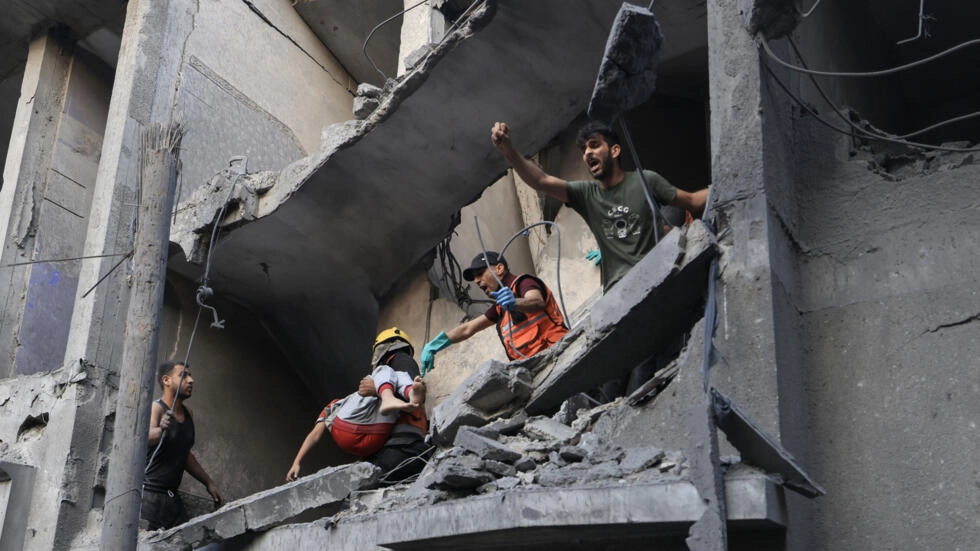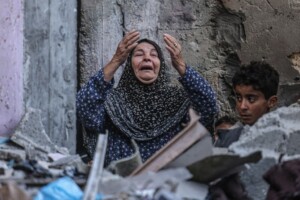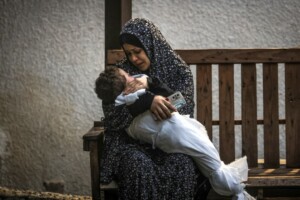We Communicate For Happy Children
 Gaza: Genocide in its Third Month - Systematic killings, myriad ways for children to perish
Gaza: Genocide in its Third Month - Systematic killings, myriad ways for children to perish 
Israel’s war on the Gaza Strip enters its third month, multiplying the disasters and the scale of atrocities against children, families, and caregivers. The number of martyrs surpasses 20,000 including over 8,000 children, with more than 52,000 wounded. According to the “Euro-Mediterranean Human Rights Monitor,” Israel has killed over 9,000 children and infants since the start of its war on the Gaza Strip. At the same time, hundreds remain under the rubble, indicating that the number of child martyrs likely exceeds 10,000 out of more than 23,000.
A week-long ceasefire wasn’t sufficient to alleviate the aftermath of the war, compounded by previous conflicts. The post-ceasefire period is harsher than before. What was repeatedly warned of during the first two months has become an inescapable reality: diseases, epidemics, shrinking “safe areas,” and the displacement of hundreds of thousands from the south to the farthest south – from Khan Yunis that is witnessing battles to Rafah bombarded by land, sea, and air – children dying due to drought and hunger, psychological traumas, on the brink of famine.
What hasn’t yet ensued is inevitable. Only two things can mitigate the consequences: an immediate and permanent cessation of fire and an urgent, unobstructed intervention, intensifying efforts to rescue children from the “mass grave” they live amidst, as expressed by UNICEF.
It’s worth noting that the repercussions of the war extend beyond Occupied Palestine, reaching neighboring Arab countries affected by Israeli strikes. A United Nations study published on December 13 mentioned the high economic cost on Lebanon, Egypt, and Jordan, potentially reaching $10 billion this year, pushing over 230,000 individuals into poverty. These countries already face significant economic crises, especially Lebanon and Egypt.
To give birth today in Gaza
Using paper scissors, clothing clips, and the light of her mobile phone, amidst Israeli bombardment sounds and the pleas of neighbors and refugees in crumbling buildings fleeing Israeli brutality, Nurse Noor Ma’in cut her niece’s umbilical cord inside their home.
Wajeeha al-Abiad (29 years old) had to wait for forty minutes for an ambulance to arrive and take her to the hospital to deliver her baby, Ahmad. In a dark, empty road except for debris and sounds of bombardment, she fumbled with her fetus inside the ambulance, speeding like lightning, fearing Israeli shelling. From Deir al-Balah in the center of the Strip to Al-Awda Hospital in Nuseirat Camp, a twenty-minute journey to Wajeeha felt like an eternity. The maternity ward was out of service; it was designated to treat a large number of war casualties. Wajeeha and Ahmad had to wait for another hour. “My childbirth experience was a nightmare in every sense of the word, like a horror movie,” the mother says, accompanied by dozens of mothers who were protecting their newborns under their clothes, fearing shattered glass from repeated shelling every five minutes near the hospital.
The story of Noor and Wajeeha reflects the stories of tens of thousands of pregnant women in the Strip. Around 50,000 pregnant women need medical services amid shortages of supplies, medicines, clean water, and proper nutrition. There’s an average of 183 births per day in the area, with an expected addition of around 5,500 births in the coming weeks. The rates of miscarriage and premature births are higher than previous averages. Mothers are forced to leave their children in makeshift hospitals and head to shelters without personal or medical necessities. This comes as Gaza’s healthcare system collapses, with most hospitals out of service – only 13 out of 36 are partially operational, according to the United Nations Office for the Coordination of Humanitarian Affairs (OCHA) under Israel’s severe restrictions on necessary fuel entry to the Strip, resulting in the deaths of premature babies, let alone the catastrophic conditions for pregnant women, new mothers, and breastfeeding women in overcrowded shelters.

A Palestinian woman reacts following Israeli bombardment in Rafah, in the southern Gaza Strip on 14 December 2023 (AFP)
“Who survives the bombing may die by illness.”
The continuation of Israel’s war on Gaza means the continuous spread of epidemics and diseases, prompting the Euro-Mediterranean Human Rights Monitor to warn of the Gaza Strip becoming a “devastated area where infectious diseases spread catastrophically and unprecedentedly in modern human history.” The residents of Gaza, half of whom are children, face a battle not only with deadly bombs and rockets but also with infectious diseases and epidemics amidst a holistic health system collapse aimed at deepening the genocide, as per the Eudo-Med HRM’s expression.
According to UNRWA, intestinal diseases in Gaza have spread four times faster than before, and skin diseases have tripled. Reports also indicate the spread of epidemic hepatitis in the Strip, alongside the emergence of other diseases like cholera. One of the UNRWA’s schools witnessed an outbreak of Hepatitis A, while the Save the Children organization stated that “those who survived the bombing are now facing the imminent threat of death due to hunger and disease,” mentioning the extraction of worms from wounds.
The conditions in shelters are indescribably dire. Around 1.9 million people in Gaza have become internally displaced and reside with their children in centers that are neither designated nor suitable for shelter amidst massive overcrowding, significantly impacting children’s safety and well-being, according to the Euro-Med HRM. According to UNOCHA, citing the Ministry of Health in Gaza, there are an estimated 360,000 cases of infectious diseases in shelters.
Children line up by the hundreds to use a single toilet. Winter engulfs the places and tents where hundreds of thousands of children and their families reside. Due to overcrowding, poor health conditions, lack of bathrooms, and sanitation services, these places record high rates of infectious diseases like diarrhea, acute respiratory infections, skin infections, and hygiene-related conditions. The fuel shortage has also led to the closure of water desalination and sewage treatment plants, increasing the risk of bacterial infections, as contaminated drinking water spreads diseases like diarrhea, dysentery, typhoid, and polio.
The risks of waste accumulation in Gaza’s residential neighborhoods are escalating, with the Strip producing around two thousand tons of waste daily, threatening to exacerbate a hazardous health and environmental catastrophe. The Euro-Med HRM gathered testimonies from doctors and health officials in international relief organizations documenting over 20,000 cases linked to upper respiratory tract infections in just the first week of December. Typically, the region records about two thousand cases monthly related to respiratory diseases in their various forms. The risks heighten as winter approaches, increasing the likelihood of waste decomposition. With bodies piling up under the rubble, estimated to be in the thousands, the risk of epidemics and diseases spreading increases.
In November, over 50 severe diarrhea cases were recorded, half of which affected children under five years old, bearing in mind that severe diarrhea, compounded by malnutrition and weakened physical conditions among the population, especially children, can lead to death.
In a further display of Israeli atrocities against children, the Palestinian Ministry of Health announced the depletion of all child vaccinations in the area, emphasizing that the health repercussions would be catastrophic for children and the spread of diseases, especially among displaced individuals in overcrowded shelters. UN organizations urged swift intervention to provide necessary vaccinations and ensure their distribution across all areas.
Famine Knocks on Gaza’s Door
Hunger grips Gaza. It’s no longer uncommon to see children scouring the streets for food in the Strip’s governorates, as highlighted by “Save the Children.” According to the World Food Programme’s report for December 2023, almost no one in Gaza has enough food. In some areas, 9 out of 10 people have spent a whole day and night without food in the past four weeks, approximately 88% of households in the northern governorates and about 54% in the southern.
The detailed report indicated alarming hunger levels in the northern governorates, where nearly half of the families experienced high or very high levels of severe hunger. Only 4% experienced low levels or no hunger at all. In the southern governorates, one-third of families reported high or very high levels of severe hunger, 53% spoke of moderate hunger, and 14% claimed they didn’t feel hungry. In short, Gaza is facing the threat of famine. According to the Euro-Med HRM, children in Gaza face a shocking risk of starving to death, especially in areas like Gaza City and its northern regions where the opportunity for a single meal daily is nearly absent for the majority of families, forcing them to resort to unsafe and unhealthy methods to cook.
People with disabilities in the line of fire and atrocity
Individuals with disabilities, especially children among them, are one of the most affected groups by the Israeli war. According to the Euro-Med HRM and the Disabilities Representative Persons Network (DRBN), the current Israeli attacks have left over 5,000 disabled individuals facing severe risks due to the significant lack of medical care and the collapse of the healthcare system.
The Palestinian Central Bureau of Statistics estimates that the current aggression has likely increased the number of persons with disabilities to 12,000. This estimate is based on previous reports from UNRWA, indicating that about a third of the injuries during the 2014 devastating war resulted in permanent disabilities for the victims at that time. Considering the current rise in casualties, reduced healthcare, the prevention of essential medical supplies from entering the area, the targeting of hospitals, care centers, and medical teams, their siege, and the arrest of some medical personnel, an increase in the number of persons with disabilities is nearly inevitable.
According to the Central Bureau, children constitute 17% of the total casualties of the current Israeli war until December 3. These children suffer from severe injuries that have long-term effects on their health and lives, often requiring repeated surgeries and expensive medical treatments. Furthermore, these injuries may lead to permanent disabilities and impairments, hindering their access to education and increasing the likelihood of psychological trauma and disorders, affecting their psychological and social development.
Persons with disabilities face significant challenges in overcrowded shelters due to a lack of healthcare and their inability to access healthcare services within these facilities. Those suffering the most are mobility-impaired individuals, especially those with lower limb paralysis, quadriplegia, and muscle atrophy, who require electricity, respiratory devices, and other inaccessible medical supplies due to power cuts and Israeli blockades. The dangers to the lives of persons with disabilities increase during forced evacuation requests or escape attempts, leaving them often stranded and exposed to life-threatening situations.
As the aggression and indiscriminate shelling persist, with a decrease in necessary medical equipment and aid, compounded by prolonged inspections of medical supply convoys in Gaza and the detention of health sector workers leading to the death of a patient, the number of surgeries performed on children, often without anesthesia and sometimes leading to limb amputations to save lives, rises. Israel’s deliberate ban on allowing thousands of patients to travel outside the Strip, only permitting around 430 injured out of approximately 49,000 injured individuals, roughly 1%, to pass through the Rafah crossing, according to the Euro-Med HRM, results in a large number of casualties and children either losing their lives or being forced to neglect the treatment of their injuries, exposing them to the risk of permanent disabilities.
Targeting persons with disabilities or obstructing medical assistance for patients due to repeated wars and severe shortages in assistive devices resulting from the Israeli blockade represents a deliberate Israeli policy preceding the current war. Before the war, the estimated number of persons with disabilities in the region was approximately 85,000, comprising 2.6% of the total population. The number of persons with disabilities doubled from around 24,000 in 2007 to over 84,000 by 2017, according to the Central Bureau. The registered number of persons with disabilities for 2022 exceeded 55,000. This policy on Gaza doesn’t differ from that adopted in the West Bank, where the estimated number of persons with disabilities before the current war was around 59,000. Israeli soldiers do not hesitate to use live ammunition against them, resulting in casualties.
This comes at a time when Israel ratified the “United Nations Convention on the Rights of Persons with Disabilities” in 2012, obligating member states to take “all possible measures to ensure the protection and safety of persons with disabilities in situations of risk, including armed conflicts.”

A woman from the Palestinian Ashour family holds the body of a baby who was killed in Israeli bombardment in Rafah, in the southern Gaza Strip on 14 December 2023 (AFP)
The psychological situation of children in Gaza
“In Gaza, there is no such thing as post-traumatic stress disorder because the trauma is repeated, ongoing, and constant,” says Samah Jibril, Head of the Mental Health Unit in the Palestinian Ministry of Health.
“My children wet themselves out of fear, terror, and cold. We have nothing to do with this. What offense have we committed?”
(Ziyad Hamad, father of a palestinian family, Report by Amnesty International, 20 October 2023)
A child born 16 years ago in Gaza has survived at least five major wars, including “smaller battles” titled “Mow the lawn” by the Israeli army. A child born last year, this year, or during this war experiences an unparalleled level of fear, as described by humanitarian and relief organizations. The accumulation of psychological traumas and disorders experienced by Gaza’s children from past events and their current circumstances includes losing one or both parents, entire families, friends, and relatives, witnessing death, bombings, destruction, the constant terror of imminent death, harsh experiences of forced displacement, and the psychological aftermath of the 16-year Israeli blockade.
In numerical terms, around 25,000 children in the Strip became orphans due to the martyrdom of one or both parents. According to estimates by the Euro-Med HRM, approximately 460,000 homes were destroyed or damaged, rendering families homeless for extended periods. About 1,550 families lost more than one family member, according to officials in the Palestinian Ministry of Health. For a child, losing their protector, whether a father, mother, guardian, or provider, leaves a tremendous psychological impact. The feeling of safety, a fundamental need for their mental and psychological development, is missing for Gaza’s children today.
The Euro-Med HRM has been speaking of mental health crises and complex disorders experienced by Gaza’s children for years, noting that 4 out of 5 children suffered from depression, sadness, or fear before the current attack, a significant deterioration compared to previous studies.
Despite the catastrophic situation, the psychological and materialistic, caregivers are aware of the seriousness of the situation for Gaza’s children. In the face of the Israeli occupation’s disregard for international laws protecting this vulnerable group and their officials’ statements about continuing the war with or without international support, caregivers risk their lives to intervene, respond, and provide support. Local associations and international workers have lost many lives while providing aid. Organizations like “Juzoor” and the “Palestinian Network for Early Childhood” are operating on the ground with concerned institutions, offering programs to meet the needs of children, families, and caregivers in these critical conditions as much as possible.
